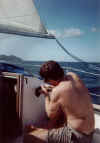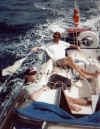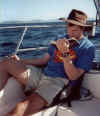Day 1: Thursday, November 13, 1997
 Morning came early and uncomfortably bright, but in spite of the cerebral fog, we were underway by 0800 after a brief swim.
Destination: Jost Van Dyke island,
where according to our guide book it was recommended we clear customs.
Morning came early and uncomfortably bright, but in spite of the cerebral fog, we were underway by 0800 after a brief swim.
Destination: Jost Van Dyke island,
where according to our guide book it was recommended we clear customs.
 It took several hours to get to JVD Island and along the way we were almost sucked ashore
by one of several alluring beaches: white sands, crystal clear waters,
palm trees to shade out the head-throbbing sun... Sailors on a mission, we sailed on.
By shortly before noon, we were ashore on JVD Island,
just in time for the customs and immigration officer to step out for an extended lunch hour.
With only a taint of regret, we decided he must know something we didn't, and joined in for a cheeseburger lunch.
It took several hours to get to JVD Island and along the way we were almost sucked ashore
by one of several alluring beaches: white sands, crystal clear waters,
palm trees to shade out the head-throbbing sun... Sailors on a mission, we sailed on.
By shortly before noon, we were ashore on JVD Island,
just in time for the customs and immigration officer to step out for an extended lunch hour.
With only a taint of regret, we decided he must know something we didn't, and joined in for a cheeseburger lunch.
 Jost Van Dyke is at the western edge of the British Virgin Islands.
Until the next hurricane comes through, it will be one of those picture postcard tropical islands
with 10 or so dwellings including a few residences, a restaurant, a bar or two, a dance bar, and a few curio shops.
Other than sun and sand, it is self sufficient in nothing. Everything else must be brought in by boat.
On such islands, it is always easy to identify the official government building.
It is the one with four walls, a roof, and a coat of paint.
All of the other dwellings are missing at least one of these components.
Jost Van Dyke is at the western edge of the British Virgin Islands.
Until the next hurricane comes through, it will be one of those picture postcard tropical islands
with 10 or so dwellings including a few residences, a restaurant, a bar or two, a dance bar, and a few curio shops.
Other than sun and sand, it is self sufficient in nothing. Everything else must be brought in by boat.
On such islands, it is always easy to identify the official government building.
It is the one with four walls, a roof, and a coat of paint.
All of the other dwellings are missing at least one of these components.
 Checking out of the BVI at this smaller island, there is only a hint of the gruff,
arrogant, studied indifference we witnessed in Tortola.
The customs-man stamps our passports, takes our money, and hands us our official piece of paper.
We are free to go. It's official. It says so on the paper.
We have successfully negotiated another potential "bureaucratic reef" without running amuck.
Checking out of the BVI at this smaller island, there is only a hint of the gruff,
arrogant, studied indifference we witnessed in Tortola.
The customs-man stamps our passports, takes our money, and hands us our official piece of paper.
We are free to go. It's official. It says so on the paper.
We have successfully negotiated another potential "bureaucratic reef" without running amuck.




 After an intense rain shower that doubled as a body shower with soap, we get under way again
(pictured from left to right: Jeff, Tony, Tony, Tony and John, John).
Over the course of the summer, the 20 year old compass on the IBIS self-destructed.
Most likely, the unrelenting tropical sun ate it.
Fortunately, Arjan had alerted me to this situation and I had brought along a replacement.
Time to get a-tinkering. In a matter of an hour, I had performed a successful compassectomy and transplant,
wired the new unit with its internal lighting, and, with the help of the GPS, trued it to North, South, East, and West.
GPS is very nice, but when the ship hits the fan, I want a good compass aboard and a spare one down below.
I am old enough to still have an instinctive distrust of electronics.
I have seen too many “blue screens of death” telling me that I have “committed a fatal error”
to trust all of my navigation to a digital device.
Call me old-fashioned.
After an intense rain shower that doubled as a body shower with soap, we get under way again
(pictured from left to right: Jeff, Tony, Tony, Tony and John, John).
Over the course of the summer, the 20 year old compass on the IBIS self-destructed.
Most likely, the unrelenting tropical sun ate it.
Fortunately, Arjan had alerted me to this situation and I had brought along a replacement.
Time to get a-tinkering. In a matter of an hour, I had performed a successful compassectomy and transplant,
wired the new unit with its internal lighting, and, with the help of the GPS, trued it to North, South, East, and West.
GPS is very nice, but when the ship hits the fan, I want a good compass aboard and a spare one down below.
I am old enough to still have an instinctive distrust of electronics.
I have seen too many “blue screens of death” telling me that I have “committed a fatal error”
to trust all of my navigation to a digital device.
Call me old-fashioned.


 In the late afternoon, we make an impromptu navigational decision to head for Charlotte Amalie
on St. Thomas in the U.S. Virgin Islands.
Bypassing the formality of customs, we cruise in and anchor as if we own the place.
Charlotte Amalie is one of a few well protected deep water ports in the Virgin Islands,
and consequently it is a favorite destination for the "Love Boats."
Piloting among these cruise ships feels a lot like sailing down through the streets of Manhattan--they tower over us.
By sundown, there are at least three of these vessels disgorging their tourist contents onto the town.
In and amongst this mass of flip-flops, Hawaiian shirts, khaki shorts, and suntan mousse,
what are three more unregistered tourists.
Besides, we are leaving tomorrow morning and we are Americans in an American land.
We makes our bets and we takes our chances.
In the late afternoon, we make an impromptu navigational decision to head for Charlotte Amalie
on St. Thomas in the U.S. Virgin Islands.
Bypassing the formality of customs, we cruise in and anchor as if we own the place.
Charlotte Amalie is one of a few well protected deep water ports in the Virgin Islands,
and consequently it is a favorite destination for the "Love Boats."
Piloting among these cruise ships feels a lot like sailing down through the streets of Manhattan--they tower over us.
By sundown, there are at least three of these vessels disgorging their tourist contents onto the town.
In and amongst this mass of flip-flops, Hawaiian shirts, khaki shorts, and suntan mousse,
what are three more unregistered tourists.
Besides, we are leaving tomorrow morning and we are Americans in an American land.
We makes our bets and we takes our chances.
 In Charlotte Amalie, the town docks are at one end of the harbor and the grocery store and restaurants are at the other.
On foot, it is probably 3+ miles from end to end and, after a very short debate, we decide to hail a cab.
In Charlotte Amalie, the town docks are at one end of the harbor and the grocery store and restaurants are at the other.
On foot, it is probably 3+ miles from end to end and, after a very short debate, we decide to hail a cab.
 Never hail a cab in Charlotte Amalie.
You can lose an arm, get run over, or start a fight by hailing a cab and, it turns out, it is a total waste of motion.
Every motorized vehicle, from moped to dump-truck, doubles as a taxi on this island of entrepreneurs.
Apparently, carting tourists around is a major, competitive industry on St. Thomas.
Without even a hand gesture, we have cars stopping to offer a ride.
One of these is a 70's vintage Vega, belching out unmuffled smoke,
already fully occupied by three overweight Island women.
We decline their offer and wait for a more taxi-like looking vehicle--something with a sign on top.
Almost immediately, a rundown station wagon with a taxi sign arrives and takes us first to the grocery store
and next to a restaurant.
Most places in the U.S., this vehicle would have already been shredded and recycled into rebar or man-hole covers.
In Massachusetts, it would definitely not be street legal.
It is probably easier to count the things that still work on this rattle-trap, than to count the broken parts.
This "taxi," more than likely, was no more or less official than the three fat ladies in the Vega,
but the sign on top gave us a false sense of security.
It seems more likely that we will eventually be allowed out of this vehicle.
Who knows what the fat ladies had in mind for us.
Never hail a cab in Charlotte Amalie.
You can lose an arm, get run over, or start a fight by hailing a cab and, it turns out, it is a total waste of motion.
Every motorized vehicle, from moped to dump-truck, doubles as a taxi on this island of entrepreneurs.
Apparently, carting tourists around is a major, competitive industry on St. Thomas.
Without even a hand gesture, we have cars stopping to offer a ride.
One of these is a 70's vintage Vega, belching out unmuffled smoke,
already fully occupied by three overweight Island women.
We decline their offer and wait for a more taxi-like looking vehicle--something with a sign on top.
Almost immediately, a rundown station wagon with a taxi sign arrives and takes us first to the grocery store
and next to a restaurant.
Most places in the U.S., this vehicle would have already been shredded and recycled into rebar or man-hole covers.
In Massachusetts, it would definitely not be street legal.
It is probably easier to count the things that still work on this rattle-trap, than to count the broken parts.
This "taxi," more than likely, was no more or less official than the three fat ladies in the Vega,
but the sign on top gave us a false sense of security.
It seems more likely that we will eventually be allowed out of this vehicle.
Who knows what the fat ladies had in mind for us.
 For dinner, we ask three locals for advice and get three different opinions,
but finally settle on a "French" restaurant overlooking the water.
"Betsy’s Bar and Lysa’s Kitchen” is exactly what I have come to expect of island eateries:
over-priced, and not all that good,
but served with a cold beer and easy to clean up after.
In fact, with only one or two exceptions, all the food on all the islands catering to tourism
exactly fits this description.
There is no bell-curve, no "stars", no appreciable diversity, ethnic or otherwise.
Every where we have been or will go, we will have the same two-star cuisine.
It is as if all of these tourist traps have exactly the same menu and perhaps even exactly the same head chef!
Jimmy Buffet is right.
Ask for the cheeseburger in Paradise because the filet mignon is likely to be inedible.
For dinner, we ask three locals for advice and get three different opinions,
but finally settle on a "French" restaurant overlooking the water.
"Betsy’s Bar and Lysa’s Kitchen” is exactly what I have come to expect of island eateries:
over-priced, and not all that good,
but served with a cold beer and easy to clean up after.
In fact, with only one or two exceptions, all the food on all the islands catering to tourism
exactly fits this description.
There is no bell-curve, no "stars", no appreciable diversity, ethnic or otherwise.
Every where we have been or will go, we will have the same two-star cuisine.
It is as if all of these tourist traps have exactly the same menu and perhaps even exactly the same head chef!
Jimmy Buffet is right.
Ask for the cheeseburger in Paradise because the filet mignon is likely to be inedible.
 Betsy's Bar is the prototype of what we flock from Boston,
New York, and New Jersey to find in the Islands.
So what if the food is not all that good?
In the dead of winter, we are sitting in shorts and tees, eating food, and rubbing elbows with the locals.
A quick glance around the restaurant and bar reveals, however, that the tourists come for food and conversations,
whereas the locals come for beer, rum, and darts.
That's right!
Pub darts.
Betsy's Bar is the prototype of what we flock from Boston,
New York, and New Jersey to find in the Islands.
So what if the food is not all that good?
In the dead of winter, we are sitting in shorts and tees, eating food, and rubbing elbows with the locals.
A quick glance around the restaurant and bar reveals, however, that the tourists come for food and conversations,
whereas the locals come for beer, rum, and darts.
That's right!
Pub darts.
 A dozen or so men are gathered around the dart board, engaged in a perpetual tournament, and taking it very seriously.
There are several "types" that are immediately recognizable.
One is the com-si, com-sa, just passing time type.
One is the athletic, dive-shop dude, as blonde and as good looking as he is dumb.
Another is Joe-Cool, wirey chain smoker wearing leather and sporting a scarf,
deadly serious and deadly accurate with the darts.
Joe-Cool seems to be winning, by his strut away from the board.
No one from the IBIS even momentarily thinks of stepping up to challenge the locals.
The "Force" is too powerful to be challenged by an outsider.
Eventually, we taxi our way back to the boat for a good night's sleep.
A dozen or so men are gathered around the dart board, engaged in a perpetual tournament, and taking it very seriously.
There are several "types" that are immediately recognizable.
One is the com-si, com-sa, just passing time type.
One is the athletic, dive-shop dude, as blonde and as good looking as he is dumb.
Another is Joe-Cool, wirey chain smoker wearing leather and sporting a scarf,
deadly serious and deadly accurate with the darts.
Joe-Cool seems to be winning, by his strut away from the board.
No one from the IBIS even momentarily thinks of stepping up to challenge the locals.
The "Force" is too powerful to be challenged by an outsider.
Eventually, we taxi our way back to the boat for a good night's sleep.
|









 In Charlotte Amalie, the town docks are at one end of the harbor and the grocery store and restaurants are at the other.
On foot, it is probably 3+ miles from end to end and, after a very short debate, we decide to hail a cab.
In Charlotte Amalie, the town docks are at one end of the harbor and the grocery store and restaurants are at the other.
On foot, it is probably 3+ miles from end to end and, after a very short debate, we decide to hail a cab. Never hail a cab in Charlotte Amalie.
You can lose an arm, get run over, or start a fight by hailing a cab and, it turns out, it is a total waste of motion.
Every motorized vehicle, from moped to dump-truck, doubles as a taxi on this island of entrepreneurs.
Apparently, carting tourists around is a major, competitive industry on St. Thomas.
Without even a hand gesture, we have cars stopping to offer a ride.
One of these is a 70's vintage Vega, belching out unmuffled smoke,
already fully occupied by three overweight Island women.
We decline their offer and wait for a more taxi-like looking vehicle--something with a sign on top.
Almost immediately, a rundown station wagon with a taxi sign arrives and takes us first to the grocery store
and next to a restaurant.
Most places in the U.S., this vehicle would have already been shredded and recycled into rebar or man-hole covers.
In Massachusetts, it would definitely not be street legal.
It is probably easier to count the things that still work on this rattle-trap, than to count the broken parts.
This "taxi," more than likely, was no more or less official than the three fat ladies in the Vega,
but the sign on top gave us a false sense of security.
It seems more likely that we will eventually be allowed out of this vehicle.
Who knows what the fat ladies had in mind for us.
Never hail a cab in Charlotte Amalie.
You can lose an arm, get run over, or start a fight by hailing a cab and, it turns out, it is a total waste of motion.
Every motorized vehicle, from moped to dump-truck, doubles as a taxi on this island of entrepreneurs.
Apparently, carting tourists around is a major, competitive industry on St. Thomas.
Without even a hand gesture, we have cars stopping to offer a ride.
One of these is a 70's vintage Vega, belching out unmuffled smoke,
already fully occupied by three overweight Island women.
We decline their offer and wait for a more taxi-like looking vehicle--something with a sign on top.
Almost immediately, a rundown station wagon with a taxi sign arrives and takes us first to the grocery store
and next to a restaurant.
Most places in the U.S., this vehicle would have already been shredded and recycled into rebar or man-hole covers.
In Massachusetts, it would definitely not be street legal.
It is probably easier to count the things that still work on this rattle-trap, than to count the broken parts.
This "taxi," more than likely, was no more or less official than the three fat ladies in the Vega,
but the sign on top gave us a false sense of security.
It seems more likely that we will eventually be allowed out of this vehicle.
Who knows what the fat ladies had in mind for us. For dinner, we ask three locals for advice and get three different opinions,
but finally settle on a "French" restaurant overlooking the water.
"Betsy’s Bar and Lysa’s Kitchen” is exactly what I have come to expect of island eateries:
over-priced, and not all that good,
but served with a cold beer and easy to clean up after.
In fact, with only one or two exceptions, all the food on all the islands catering to tourism
exactly fits this description.
There is no bell-curve, no "stars", no appreciable diversity, ethnic or otherwise.
Every where we have been or will go, we will have the same two-star cuisine.
It is as if all of these tourist traps have exactly the same menu and perhaps even exactly the same head chef!
Jimmy Buffet is right.
Ask for the cheeseburger in Paradise because the filet mignon is likely to be inedible.
For dinner, we ask three locals for advice and get three different opinions,
but finally settle on a "French" restaurant overlooking the water.
"Betsy’s Bar and Lysa’s Kitchen” is exactly what I have come to expect of island eateries:
over-priced, and not all that good,
but served with a cold beer and easy to clean up after.
In fact, with only one or two exceptions, all the food on all the islands catering to tourism
exactly fits this description.
There is no bell-curve, no "stars", no appreciable diversity, ethnic or otherwise.
Every where we have been or will go, we will have the same two-star cuisine.
It is as if all of these tourist traps have exactly the same menu and perhaps even exactly the same head chef!
Jimmy Buffet is right.
Ask for the cheeseburger in Paradise because the filet mignon is likely to be inedible. Betsy's Bar is the prototype of what we flock from Boston,
New York, and New Jersey to find in the Islands.
So what if the food is not all that good?
In the dead of winter, we are sitting in shorts and tees, eating food, and rubbing elbows with the locals.
A quick glance around the restaurant and bar reveals, however, that the tourists come for food and conversations,
whereas the locals come for beer, rum, and darts.
That's right!
Pub darts.
Betsy's Bar is the prototype of what we flock from Boston,
New York, and New Jersey to find in the Islands.
So what if the food is not all that good?
In the dead of winter, we are sitting in shorts and tees, eating food, and rubbing elbows with the locals.
A quick glance around the restaurant and bar reveals, however, that the tourists come for food and conversations,
whereas the locals come for beer, rum, and darts.
That's right!
Pub darts. A dozen or so men are gathered around the dart board, engaged in a perpetual tournament, and taking it very seriously.
There are several "types" that are immediately recognizable.
One is the com-si, com-sa, just passing time type.
One is the athletic, dive-shop dude, as blonde and as good looking as he is dumb.
Another is Joe-Cool, wirey chain smoker wearing leather and sporting a scarf,
deadly serious and deadly accurate with the darts.
Joe-Cool seems to be winning, by his strut away from the board.
No one from the IBIS even momentarily thinks of stepping up to challenge the locals.
The "Force" is too powerful to be challenged by an outsider.
Eventually, we taxi our way back to the boat for a good night's sleep.
A dozen or so men are gathered around the dart board, engaged in a perpetual tournament, and taking it very seriously.
There are several "types" that are immediately recognizable.
One is the com-si, com-sa, just passing time type.
One is the athletic, dive-shop dude, as blonde and as good looking as he is dumb.
Another is Joe-Cool, wirey chain smoker wearing leather and sporting a scarf,
deadly serious and deadly accurate with the darts.
Joe-Cool seems to be winning, by his strut away from the board.
No one from the IBIS even momentarily thinks of stepping up to challenge the locals.
The "Force" is too powerful to be challenged by an outsider.
Eventually, we taxi our way back to the boat for a good night's sleep.